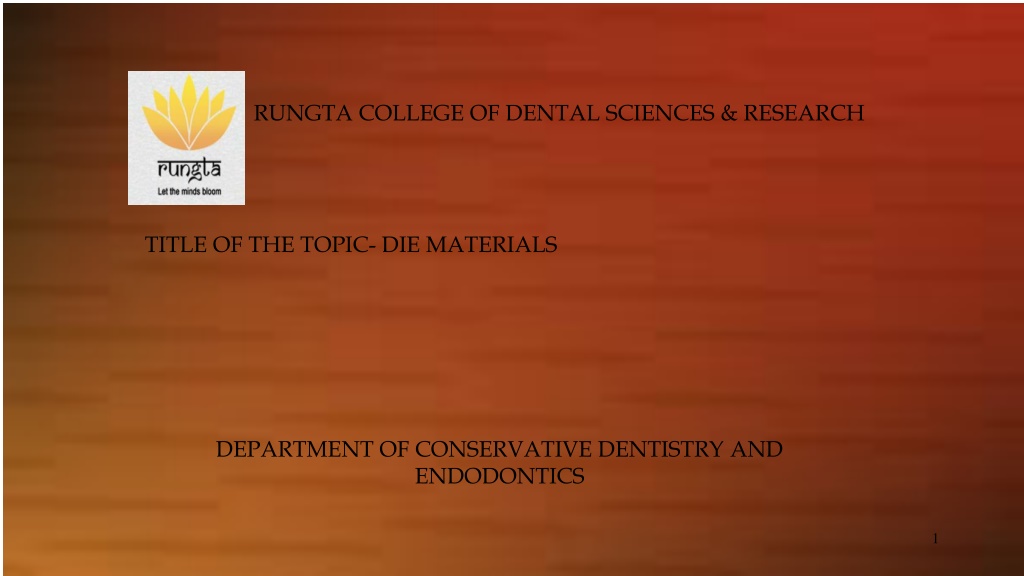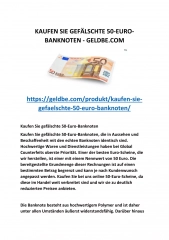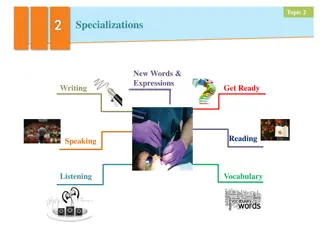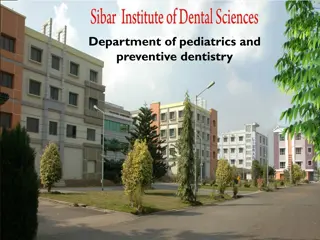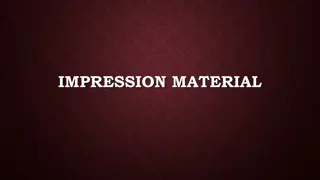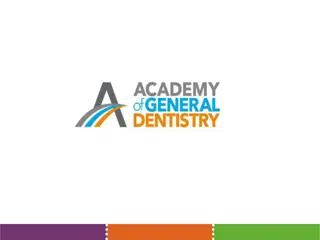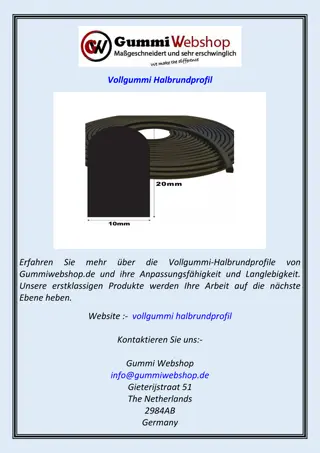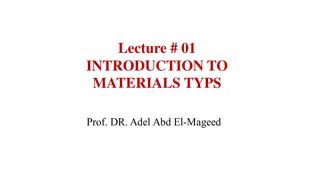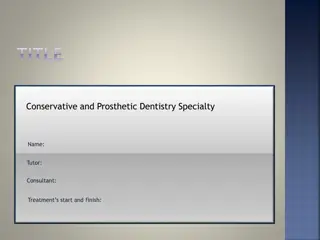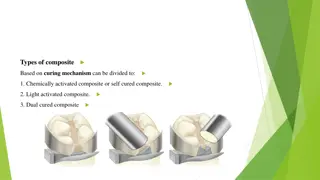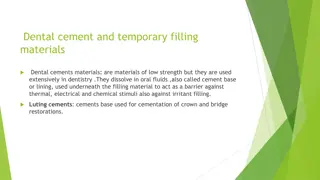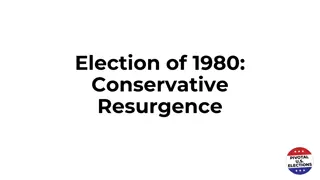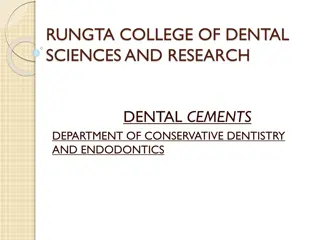Die Materials in Conservative Dentistry
Die materials play a crucial role in conservative dentistry procedures by providing accurate reproductions of prepared teeth. Learn about ideal requisites, classification, and different systems of die materials for successful restorations.
Download Presentation

Please find below an Image/Link to download the presentation.
The content on the website is provided AS IS for your information and personal use only. It may not be sold, licensed, or shared on other websites without obtaining consent from the author.If you encounter any issues during the download, it is possible that the publisher has removed the file from their server.
You are allowed to download the files provided on this website for personal or commercial use, subject to the condition that they are used lawfully. All files are the property of their respective owners.
The content on the website is provided AS IS for your information and personal use only. It may not be sold, licensed, or shared on other websites without obtaining consent from the author.
E N D
Presentation Transcript
RUNGTA COLLEGE OF DENTAL SCIENCES & RESEARCH TITLE OF THE TOPIC- DIE MATERIALS DEPARTMENT OF CONSERVATIVE DENTISTRY AND ENDODONTICS 1
Specific learning Objectives At the end of this presentation the learner is expected to know ; Core areas* Domain ** Category # Introduction Method Armamentarium Cognitive Psychomotor Cognitive Must know Must know Must know *Subtopic of importance ** Cognitive, Psychomotor or Affective # Must know , Nice to know & Desire to know ( Table to be prepared as per the above format ) 2
CONTENTS Introduction Ideal requisites of die materials Classification of die materials Different die materials Different die systems Conclusion References
INTRODUCTION : Die is the positive reproduction of the form of a prepared tooth in any suitable substance. A die must be an accurate reproduction of the prepared tooth both in dimensions and surface details. It must represent all of the prepared surfaces, including the margins and a reasonable amount of the uncut apical position of the tooth.
A die must be made of a material that is Dense Hard Capable of being used in the production of wax patterns and in the fitting and finishing of castings without undue risk of damage to its surface.
Because direct fabrication of patterns for extracoronal restorations in the mouth is inconvenient Difficult Time consuming Virtually impossible, practically all wax patterns are made in the laboratory with the indirect technique.
IDEAL REQUISITES OF A DIE MATERIAL : 1.Die material should be compatible with the impression materials. 2.Dimensional accuracy and stability material should remain dimensiona- lly stable on storage.
3. Reproduction of detail The ability to reproduce fine detail and sharp margins is essential. 4. Mechanical properties High strength is important. 5. Color-Good color contrast with other materials being used.
5. Toughness -To allow burnishing of foil and resist breakage. 6. Easy and quick manipulation and rapid fabrication. 7. Non-injurious to health by touch or inhalation. 8. All surfaces must be accurately duplicated and no bubbles or voids can be accepted. 9. Economical.
CLASSIFICATION OF DIE MATERIALS : 1. Inorganic materials a. Die stone, based on calcium sulfate hemihydrate Eg. Velmix b. Dental cement zinc silicophosphate c. Ceramic materials, fired at 6000C. 2. Metallic materials a. Dental amalgam b. Metal sprayed dies (Bismuth-tin alloy) c. Electroplated dies i. Copper plated ii. Silver plated
Dental gypsum products are available in 5 forms (ADA Types I to V) Type I Impression plaster Type II Model plaster Type III Dental stone (Class I stone or Hydrocal) Type IV High-strength dental stone (class II stone, densite, or improved stone) Type V High strength, high expansion stone.
ADVANTAGES The die stone is relatively *Inexpensive *Easy to use *Compatible with all impression materials. Disadvantage * Susceptibility to abrasion during the carving of the wax pattern.
Variations in Die techniques and materials : * Several means are used to increase the resistance to abrasion. * Gypsum hardeners, such as aqueous colloidal silica or soluble resin restorations, can be used instead of water during mixing * Resistance to abrasion is increased by approximately 100%. of the stone. * Disadvantage is the slightly increased setting expansion.
Die stone investment combination medium have a comparable composition. A commercial gypsum bonded material called divestment is mixed with a colloidal silica liquid. In this the die material and the investing The die is made from this mix and the wax pattern is constructed on it.
Divestment is a gypsum-bonded material, it is not recommended for high-fusing alloys. Detail reproduction, contact angle and die hardness of elastomeric impression and gypsum die material combinations. parameters, interfacial contact angle and die hardness for some combinations of polyvinyl siloxanes, polyether, polysulfide and reversible hydrocolloid impression materials and type IV, Type V and resin reinforced type IV stone. This study compared the surface detail
1. Adequate detail reproduction of prepared teeth may be achieved with the combination of any of the elastomeric impression materials with any of the die stone materials tested. 2. When using polyvinyl siloxane or polyether impression material, type IV-resin reinforced die stone may produce dies that are less scratch resistant on the surface than the type IV die stone used in this study. 3. No overall combination of die and impression materials was identified as superior to another for all of the surface properties studied.
Electroplated Dies / Electroformed Dies : of gypsum. Used to overcome the poor abrasion resistance Advantages High strength, Hardness Abrasion resistance. of metal typically 8 hrs The time required to produce a cohesive film
TAKE HOME MESSEGE/ FOR THE TOPIC COVERED (SUMMARY) The ease with which a restoration is fabricated and the accuracy with which it will fit the mouth is materially affected by the casts and dies. So a die material should be selected that has Good dimensional accuracy, Abrasion resistance and Ability to reproduce fine detail and sharp margins. 19
Question & Answer Session 1. Write in brief about die preparation. 2. Write a short note on dowel pins. 3. Write a short note on die stone. 4. Write in brief ideal requirements of die materials. 20
REFERENCES 1. Johnston s Modern practice in fixed prosthodontics. 2. Dental materials- Properties and manipulation Craig, Obrein, Powers, 5th Edition. 3. Restorative dental materials Robert, G. Craig and John H. Powers, 11th Edition. 4. Anusavice - Phillips Sciences of Dental materials, 10th Edition. 5. Contemporary fixed prosthodontics Stephen F. Rosenstiel 3rd Edition. 6. IJP 2000 Vol 13, No: 3 pp: 214-20. 7. JPD 2000 Apr; Vol 83 No: 4 pp: 466-73. 8. JPD 2000 Mar; Vol 83 No. 3 pp: 301-5. 9. JPD 1998 Oct; Vol 80 No. 4 pp: 485-9.
